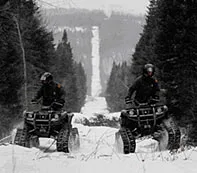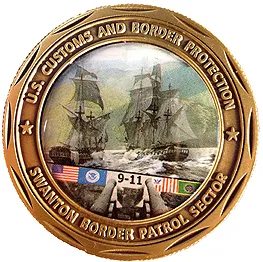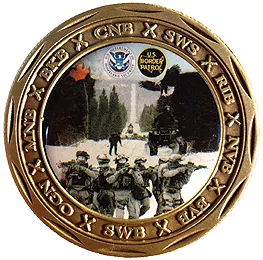Welcome to the Swanton Sector of the United States Border Patrol.
This office provides law enforcement support for the State of Vermont; Clinton, Essex, Franklin, St. Lawrence and Herkimer counties of New York; and Coos, Grafton and Carroll counties of New Hampshire. This site provides Sector-related information including Sector operations, Sector contact information, where our stations are located, and news.

History
The first Border Patrol Sector Headquarters in this area was established in 1924, at Newport, Vermont. The office was later moved to Derby Line, VT, on the border about 20 miles north of Newport. In July 1940, the Border Patrol force in Vermont was tripled to 66 officers. Stations were established at Plymouth, NH, and White River Junction and Rutland, VT, in October 1940. Ten months later, the Plymouth office was closed. The White River Junction, Island Pond, and Rutland offices were closed in 1946.
In November 1949, the Newport Sector was closed and re-opened as the Rouses Point Sector, with jurisdiction over the entire state of Vermont, Clinton, Essex, and Washington counties in New York, and Coos, Grafton, and Carroll counties in New Hampshire. In July 1956, the Sector Headquarters was moved to St. Albans, VT, and Warren County, NY was added to the sector area. On October 3, 1965, Sector Headquarters was moved to a new facility, where it currently remains, in Swanton.
On July 1, 1982, the Ogdensburg Sector was closed and a portion of the Ogdensburg territory was assigned to Swanton. This new portion included the counties of Franklin, St. Lawrence, Hamilton, and a portion of Herkimer County, all in the state of New York.
In 1949, wartime appointees were released in a reduction in force action. From that time, until the Immigration Reform and Control Act of 1986, the authorized personnel level of the Sector remained fairly steady.
Area of Responsibility
The Swanton Sector area of responsibility encompasses some 24,000 square miles and includes all of the state of Vermont; Clinton, Essex, Franklin, St. Lawrence, Hamilton, and Herkimer Counties of New York; and Coos, Grafton, and Carroll Counties of New Hampshire.
Front:
The front side of the coin has the Green Mountains and in the forefront displays ships on Lake Champlain that were utilized during the Battle of Plattsburgh, also known as the Battle of Lake Champlain. The Battle of Plattsburgh ended the final invasion of the northern states during the War of 1812. Centered between the service flags below the ships is 9-11, a historic date that has dual meaning and significance to the Swanton Sector. Everyone is aware of the significance of September 11, 2001; however, not everyone is aware that in Swanton Sector on September 11, 1814, the Americans defeated the British and forced British ground troops back into Canada.

Back:
The reverse side of the coin is meant to display current tools and tactics that agents commonly use to perform their daily duties. Daily activities in our area of operations that are shown on the coin are sign cutting on the slash via foot, ATV and snowmobile. The maple leaf signifies our proximity and partnerships with Canada, while the bald eagle represents the United States. At the base of the coin depicts all Border Patrol Agents who are available to rapidly respond to our ever changing threats.

The discreet catamount, once prevalent throughout Swanton's area, is subtly hidden in the coin's background symbolizing the ever present vigilance that Swanton Sector agents and employees continue to demonstrate on a daily basis. Along the circumference of the coin you will find the abbreviations of all the Stations, to include Sector Headquarters and its components inclusive, in recognizing that it takes all of us to make this Sector what it is today.

